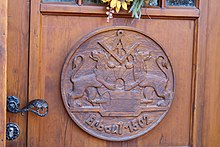Stegmühle (Hainzell)
| "Stegmühle" (Hainzell)
|
||
|---|---|---|
|
Stegmühle on the Lüder |
||
| Location and history | ||
|
|
||
| Coordinates | 50 ° 32 '30 " N , 9 ° 29' 35" E | |
| Location |
|
|
| Waters | Lüder | |
| Built | 1502 | |
| Status | fully functional | |
| technology | ||
| use | Flour mill | |
| Grinder | 1 grind, one shot | |
| drive | Watermill | |
| water wheel | undershot Eisenwasserrad, 44 blades, diameter 5.40 m | |
| Website | http://www.stegmuehle-hainzell.de/ | |
The Stegmühle is one of the oldest still in operation watermills on the Lüder in the Hosenfeld district of Hainzell , Fulda district , East Hesse . It stands at the northern exit of Hainzell, An der Brücke 8, and owes its name to the fact that before the bridge was built in 1852 there was a footbridge over the Lüder.
history
The Stegmühle was first mentioned in the building permit from April 14, 1502. The permit was granted by the Blankenau provost Ebert von Buches, the abbess Anna, the prioress Elysabet and the convent of the monastery to Wigand Morn, his wife Margret and both heirs. It included the construction of a grinding , beater and fulling mill . The mill stood at a ford through the Lüder, where today's stone bridge has stood since 1852.
Until 1910 the mill was still an oil and grinding mill with two wooden water wheels . One of the two water wheels was defective and was expanded with the oil mill in the same year. In 1926 the second mill wheel was also defective and was replaced by an iron mill wheel with a pinion gear from the König company in Fulda. The new water wheel was brought from Fulda to Hainzell (approx. 20 kilometers) with horses and three carts and riveted together on site. This water wheel still turns today and drives the mill. In 1935 the grinding gear was replaced by a roller mill . In 1965 the hexagonal sifter was replaced by a plansifter .
Today's operation
The mill is a backfill mill, of which only a few still work in Germany, with an intensive cleaning system, a roller mill, a plansifter and a shot gallery . An aspiration system evacuates the machines and the pipe system. The products are conveyed from the cellar to under the roof by augers and elevators. All machines that are necessary for cleaning the grain are located in the mill and are used daily for flour production.
Rye, wheat and spelled from controlled organic and conventional cultivation are ground. The flour obtained is sold to bakeries, self-marketers and private households. Mill products are sold in the mill shop attached to the fully functional and still producing museum mill.
literature
- Helmut Engel (general editor): Festschrift - 700 years of Hainzell 1279–1979. Ed. On the occasion of the 700th anniversary in 1981, the Hosenfeld community council. Print shop Anton Hofmann & Sohn, Tann (Rhön) , 1981.
Web links
- Behind the scenes of the Hainzell Stegmühle - guided tour by SHG Herbstein
- Sandra Kaub ensures the continued existence of the Stegmühle in Hainzell fuldainfo.de from December 25, 2017, accessed on March 16, 2018.
- Homepage of the mill
Footnotes
- ↑ "Ebert of the book, Provost, Anna abbess, Elyzbett prioress, and the convent of the monastery Blangkenauwe belehnen Wigand Morn, whose wife Margaret and two heirs with a " fleckn uence of gemeyn unssers Dorffs Hein cell location for the dorff benyden the large webs " , so that he could build a grinding, beating and fulling mill on it, with which she, the exhibitors, Wigand Morn, his wife Margret and both heirs also lend Half is due to the convent and the provost; the latter is also entitled to a nice bread worth 5 grams at Christmas. The chapel at Heinzelle is supposed to pay 1.5 pounds of wax on the mill. " (Translation of the document of April 14, 1502; Marburg State Archives, K 423 fol. 202 rv (No. 324) - from the estate of Prof. Dr. Josef Leinweber (Fulda); Library of the Episcopal Seminary in Fulda)
- ↑ During a maneuver in the Electorate of Hesse, a soldier drowned while crossing the ford, and the bridge was built in 1852.






